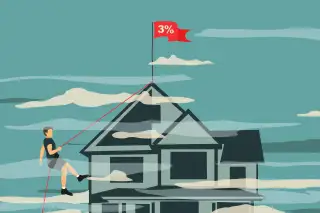Mortgage Rates Just Dropped Below 3% for the First Time Ever. The Real Story Is Why They Aren't Even Lower

The average rate on American’s favorite home loan just dropped below 3% for the first time. That’s the lowest average since Freddie Mac began tracking rates five-decades ago. It’s also the seventh record this year and marks a new low for every week in July so far.
Record low rates have already set off a refinancing boom with applications more than doubling from last year. Buyers are also flooding the market, though a lack of new listings has led to bidding wars and higher home prices in many places. A deal is a deal. Borrowers are right to be pleased and shopping—but history and some basic math indicate rates could be even lower.
Last week, the interest rate on a 30-year fixed-rate mortgage averaged 2.98% with 0.7 discount points paid, according to Freddie Mac. That’s a 0.05 percentage point drop from the previous week and 0.83 percentage points lower than a year ago, saving $125 per month on a typical home.
The cause of the slide, of course, is the coronavirus. Mortgage rates have been declining since March, when the Federal Reserve slashed short-term interest rates to zero in an effort to keep money moving through the economy, which had all but shut down in an effort to stop the virus’ spread. With cases rising and the economic path still uncertain, rates crossing into sub-3% territory started to be viewed as almost inevitable .
But it’s a milestone that would have been as unimaginable as a worldwide pandemic not long ago.
Freddie Mac published its first weekly look at mortgage rates in April 1971. The average rate at the time was 7.31%. Rates climbed as high as 17.6% in 1982, as the Fed tried to put a lid on rampant inflation by hiking up the federal funds rate. (Basically, the exact opposite of what today’s Fed is doing.) Starting in 1990, though, mortgage rates have trended lower and crossed below 4% for the first time in 2011. They’ve yo-yoed since then, but moved more-or-less in step with the yield on the 10-year Treasury note—until now.
While not an exact science, it's a well accepted gospel on Wall Street that the 30-year mortgage rate tracks the 10-year Treasury yield. Most homeowners move or refinance within a decade, which means investors who bought those loans get paid back. On Wednesday, the yield on the 10-year Treasury was 0.64%. (Before the start of the coronavirus pandemic in March, the note’s yield had never dipped below 1%, even during the financial crisis.)
The difference between the two rates is currently 2.34 percentage points. The typical spread? 1.8 percentage points. On Thursday, Len Kiefer, deputy chief economist at Freddie Mac tweeted: “if spreads tighten the 30-year mortgage rate could head to under 2.5 even with no change in Treasury/MBS yields.” (MBS stands for mortgage back securities.)
That may take awhile. So, with rates already boosting demand far ahead of supply any buyer who finds a home they love—and can afford—should not wait to see what happens.
More from Money:
Mortgage Rates Are at Record Lows. But What Does It Take to Actually Qualify for a 3% Loan?